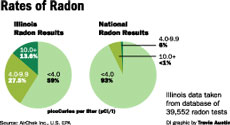High radon levels in county

Travis Austin
January 26, 2006
Residents in Champaign County are living with high quantities of radon. Long periods of exposure to radon could result in lung cancer according to the United States Environmental Protection Agency.
The dangers of radon have driven the EPA to declare January National Radon Action Month to increase awareness of the dangers of elevated radon levels.
Radon is a naturally occurring radioactive gas. It is released into the environment due to the breakdown of radium and uranium. Exposure to radon is especially dangerous because it lacks color, odor and taste, creating no warning signs.
Radon levels in homes are a problem throughout the country, but more than 40 percent of homes in Champaign County have dangerous levels of radon. Illinois’ radon levels are four times higher on average compared to the national levels. In Illinois alone, radon causes 600 to 700 deaths yearly. These alarming numbers have created $260,000 of federal funds and an accompanying $260,000 from the state through materials and labor for the state radon program, said Pat Daniels, a health physicist with the Illinois Emergency Management Agency’s State of Illinois Radon program.
“Champaign County is in zone one,” said Michael Flanagan, a health physicist for the Champaign Urbana Public Health District. “Zone one areas have the greatest risk for radon concentration. The EPA recommends that every house in zone one area be tested for radon.”
Get The Daily Illini in your inbox!
Radon is the second leading cause of lung cancer next only to smoking, and it causes the most deaths out of all in-home hazards.
“(The EPA) estimates about 21,000 people nationally die of radon related lung cancer (each year),” Daniels said.
Michael Flanagan agrees with the EPA’s urgency to create awareness about the dangers of elevated levels of radon.
“It is something we want to get people in the county aware of,” Flanagan said. “There could be a problem in their home. It’s not going to cause someone to become visibly sick, but it can be there.”
Daniels stated that he receives 150 to 200 phone calls concerning radon issues every month.
“Radon is an issue all over Illinois, and we recommend that everyone test their home for radon,” Daniels said. “There is no ‘safe’ level of radon.”
Michael Murphy, health physicist for the EPA, explained that radon could seep from the exterior of a home through entry points exposed to rocks, water and or soil.
“Entry points can be such things as cracks in the foundation, which can be micro cracks that may not always be visible, in the floor wall joints around foundations or basements, or also it can come in sump pump areas if they’re not properly sealed off,” Murphy said.
He said that any home can be susceptible to elevated radon levels.
“It doesn’t make any difference if you have a new home or an old home,” Murphy said. “It has more to do with the cracks in the foundation, the heating and cooling system how it is working, as well as the living patterns of the people.”
Though there are dangers, the consequences of elevated levels of radon can be avoided.
The Champaign Urbana Health District is giving away free test kits with charcoal canisters throughout January, February and March to help promote radon awareness. Test kits are also available at most home improvement stores, Murphy said.
Flanagan said the process is fairly simple.
“Once it is determined that you do have a problem, there are mitigation steps,” Flanagan said. “The mitigation company would retest to ensure that there is a problem. Once they mitigate the structure, put the system in to vent the gas, they will do another test to ensure that the radon levels have decreased to a level that is acceptable.”
Champaign’s HDC Engineering’s licensed radon measurements professional, Paul Fish, stated that his company deals with 20- to 30- radon mitigation installations every year. Materials and installation total around $1500-$2500 and installation takes one or two days, Fish said.
However, the EPA also warns homeowners that radon levels can rise again after a single reading.
The EPA suggests retesting every three to five years.
“Also, if there is any remodeling done in any ground contact areas then retesting should also occur,” Murphy said.






